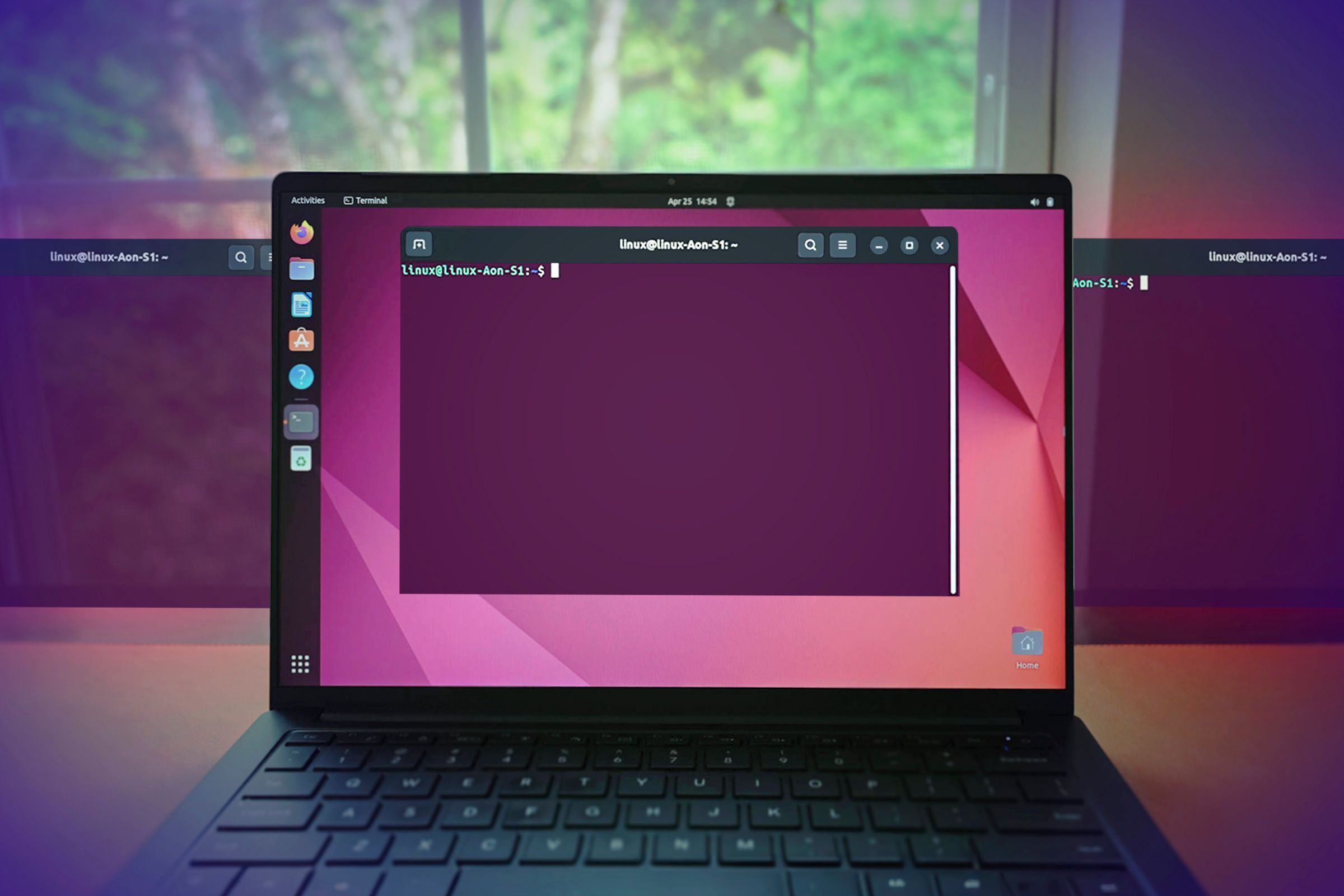Yes. I’ve been using Ubuntu and now Kubuntu for about 12 years and I don’t use the CLI. I don’t play computer maintenance guy, so don’t need any weird hacks. I just use my applications, which all have GUIs. I don’t need the CLI despite people telling me I need to use it. They have never tried GUI only. So they don’t know what they are talking about. The next lot, who typically have no idea about usability, tell me I’m missing out on something. But it’s always something I’ve never needed. If I were to use the CLI, I would need to spend ages researching not just some command, but a whole lot of other concepts that I have no clue about, only to forget it all if I ever need that again. So not as fast as people claim. Luckily, Desktop Environment developers know this and put a lot of effort into making them user friendly. They understand usability. And that different users have different needs.
So I never planned on using the cli, but the thing is, when you’re following a tutorial — say you’re installing/configuring something new — it is so much easier to copy/paste commands than it is to read instructions and then translate them to your own particular GUI environment. Once you’ve done that a few times, you’re already one of us
It’s better to learn how to do it in your own environment, than having to learn a whole new strange environment. Especially one that is not user friendly, with poor visual feedback, intolerant of any mistype, and requiring memorising.
But the GUI also requires memorizing — often steps that are not consistent across desktop environments, or even versions of the same one! Terminal commands otoh can be noted down for later use — and the terminal remembers them. I use the GUI for some things too tbc — it depends on your use case obvs — but you don’t need to pretend the terminal is this genius-hacker level of inaccessible, because it’s really not
Memorising does not need to be precise with a GUI, as you are given visual cues and can see the next step to click. You don’t need to remember precisely every letter or it fails. You don’t even need to remember the name of an application. The desktop app launcher shows you which apps you have installed. I often pin apps to favourites as a reminder. Some Appimage apps don’t appear in the launcher. I forget I have them installed and they don’t get used.
Differences between Desktop Environments are easily found when you change. As GUIs are in many users comfort zone. We use them all the time. People know their home environment, and differences need only just that discovering. Not a whole new environment.
Yeah tbc once again I do actually use a GUI as well, I just think you’re doing yourself a disservice if you refuse to even try using the terminal, because it’s not as hard as you’re telling yourself it is. For example, typing ‘firefox’ and hitting enter is way easier than looking for the icon and clicking it. When I was first starting out with it, I mainly worked by cycling through previous commands with the up key. Then you learn about Ctrl+R and you are flying.
Again, if you don’t want to use the terminal that’s up to you, and a perfectly reasonable preference. But don’t make out that you couldn’t learn it very quickly if you wanted to, because you definitely could!
I launch favourite commands with 2 clicks. Once on the App launcher button, and once on the App itself. My hand is on the mouse anyway. So it’s fast. Way faster than typing a whole bunch of characters. For less used apps It’s 3 clicks as I’d open a category like “Media” or “Games”. And doing that, I get to see what I have in there. This builds up a picture in the users head for future use. Learning “Add to favourites” is time well spent. It can even be called “Pin to Start” or “Bookmark on Launcher” it doesn’t matter. You don’t need to memorise that exactly like the CLI. And right-clicking things is already second nature to huge numbers of users.
So I have no incentive to use text commands. It’s not faster. My hand is on the mouse for my apps anyway. And the CLI has terrible usability, via poor learnability, zero tolerance, and poor visual feedback. And completely useless for most things I do, like working with 3D models, images or drawings. I’m not a “text-worker” like IT tend to be. Plus, I want more non-IT people to use Linux, so discovering the easy ways to do things can help spread the word to them.
For me it would be like stepping off a high-speed train and walking over uneven ground instead.
Ok but if we’re talking about our own personal rigs, I launch favorite commands with one keystroke. I absolutely guarantee I can boot up my computer, navigate to whatever working directory and already have gotten to work before you’ve clicked on your second icon. But it’s different use cases isn’t it? I can definitely see how if you’re using the mouse anyway, a GUI suits you better. I work mainly with text, but so do most people, I think? It’s terms like “terrible usability” etc that I’m taking issue to here, because you’re talking out of your arse. You admit that you’ve never bothered to learn, then make sweeping proclamations as if everyone on earth uses their computer primarily for Blender
Package management is probably the biggest thing a Linux user might need to use the terminal for. The graphical package managers used by default on most desktop environments are far too limited.
KDE’s Discover for instance is capable of installing (graphical) desktop applications, uninstalling packages and performing updates. Sure, it supports native packages on the majority of distros through PackageKit, as well as Flatpaks and Snaps, but it can only perform very basic package manager operations. I imagine most users will at some point need to install a package that isn’t a graphical desktop application, such as a driver or an optional dependency and they will need to use the terminal for it.
To my knowledge, this is also the state of most other graphical package managers that take the form of “software centers” like Discover. More powerful graphical package managers do exist, usually specific to a specific package manager such as Octopi for Pacman. Few distros ship with them, however. I believe one notable exception is OpenSUSE with YaST. There’s also dnfdragora on Fedora, which is pretty basic, but might be good enough for most purposes.
There is also Synaptic which is a graphical front-end for apt, although I would definitely class it as less user friendly than Discover and the like.
I know if I was doing some Linux challenge with no terminal it would have to be my crutch.
Edit: Arch Linux has pamac which I used more frequently than the terminal back then.
This whole threat is a HUGE circle jerk and a collection of all the “I USE ARCH BTW” variations imaginable.
“WHY WOULDN’T ALL PEOPLE WANT THE KNOWLEDGE TO CRAFT COMMANDS TO MANIPULATE, FILTER AND SEARCH TEXT IN A WHOLE FILE SYSTEM WITH JUST ONE COMMAND? UNCULTURED PESANTS”
Come, not everyone is a computer nerd, nor everyone ones to optimize 30s in the workflow if it means memorizing a bunch of commands, their syntax and options.
If you want to use Linux without the terminal nowadays it’s pretty easy. But also I think the fear of the terminal is part of the culture that consumer electronics have cultivated where people don’t know (or want to know) how their systems work.
If you take the time to use it, not only can you save yourself time, but also learn a lot more about how you can fix things when they go wrong! That kind of knowledge gives you so much more ownership of your system, because you don’t have to rely on your manufacturer to solve problems for you.
Same for Mac and Windows too, the terminal is something that shouldn’t be necessary, but when it is it helps to know what you’re doing. :)
I think not everyone needs to know how their device works. Specialization is what advances us as humans after all. If they wanted to know, good for them, and if they don’t also good for them. If I were using a car, I don’t need to know how the engine convert a chemical energy, transfer power, and generate thrust
I could not agree more. The number of people in here who are demanding that everyone who uses an OS understand it completely is absolutely ridiculous. I’d love to sit down and watch these people rebuild a lawnmower engine or service the compressor on their refrigerator. Hell, a shocking number of people I meet don’t know how to cook for themselves and they’re going to demand that end users be able to chroot and save a nonbootable system? Get out of here.
Ikr? “Since it interest me, it you interest you too”
It’s pretty unreasonable to expect people to know all the intricacies of their OS unless it’s their job, but I do think people could stand to treat their computer less like an unknowable magic box when they need to work with it and take a few minutes to try any basic troubleshooting at all. An example of the sort of thing I’m talking about, last year, my fan stopped working nearly as well and began making crazy amounts of noise. Could I explain to you how the motor in my fan works? Absolutely not. But I unplugged it, looked up how to disassemble it and got out my screwdrivers and opened it up to see if there was anything that I could see wrong with it. Turns out there was a lot of hair wrapped around a shaft and the base of the blades that built up over the years I’ve had it, and removing that and reassembling it was all it took to get it working fine again.
Plenty of people don’t want to put in even that small amount of time and effort to understand things when it comes to computers, which is also a valid choice of its own, but they tend to annoy me when they attribute being unable to do something to the system being too complicated to understand/use, rather than owning their decision to focus their time and energy elsewhere. There are absolutely complex programs that are not accessible for non-tech people on Linux or the BSDs, but the same could be said for Windows and Mac. In the case of the other two, people just choose the option that works for them, but with Linux, they decide ahead of time that Linux is tough and complicated and don’t even try. It could be something as simple as they want to install Debian and need non-free firmware to use their wireless card, there are people who will declare this to complicated to understand and discard the idea of using an OS entirely over a question that can be resolved in less than 5 minutes with a quick search and nano, all because “Oh, I’m not a computer person, it says terminal.”
Yeah, you do make a good point about misattributing the system being incapable to their lack of research. But people don’t like it when they are wrong/corrected most of the time. It also applies everywhere, computers just so happen to be the most prominent. The point is that people will complain about anything anywhere.
You bring up an example of installing Debian and needing non-free firmware for their wireless card. Take a step back and think how many people are even aware about the term non-free? It is quite a ubiquitous english word with different meanings in the open source community. People reading it will assume they know what it means.
The scenario when someone that is fed up with windows and decides to install debian will see the word “non-free” and attribute it to “you must pay” at glance. If the resource they used to install it mentions and clarify what non-free means, good. Otherwise, it can be a boogeyman for them and make them re-think their decision to switch.
Contrast that with CLI where if you forgot or don’t know any command there is little help or indicator of what’s available and what can be done without external help.
manwould like to have words with your strawman.And how does the user suppose to know to type
man? He may remember the instructions to check man, but he may not. For us, those 3 letter words are very familiar, but others need time to remember them. On GUI, this is no problem because as I stated they will bound to find it by exploring. Basically point and click adventure games I guess rather than the guessing game. And users will choose the path they most familiar first.Bigger problem, even if they know about MAN pages, remembering what their looking for is hard. You can’t type ‘man dnf’ if you don’t remember what your package manager is called.
I wonder how feasible searching MAN pages is.
Yeah good point. Navigation can be unintuitive too. Like, how do you quit? Is it q? Ctrl+C? What even is the weird symbol before C? Those are some of the hurdles that must be overcome when coming to CLI and not necessarily easy to remember. Sure you can do it in 1 hour, but say tomorrow would you remember it again? What if the system is running smoothly for 1 month and you never opened the terminal again after those 1 hour?
You don’t need man, just type the command with no arguments and you’ll get the help message.
Alright, try it with
cat
Do you know how everything in your house works? How to repair everything? No right?
Would you be brave enough to mess with the grounding of your house, or the AC or the heaters, the washing machine, the doors? Not eveyone wants mess with every (subsystem) thing in their house/live"
Most of the people I know want their PC to work and if somwthing goes wrong they just send it to repair or ask somebody else to fix it, they don’t wanna do it themselves, which I find normal, they have little to no interesting in PCs, and that is compleatly fine.
And before someone says "Yeah, but the computer won’t kill you if you fuck up the fixing or messing, let me tell you, a “sudo rm -r” or “sudo chown -R” can fuck you system BAR, making you loose important data and info.
-…But refugee -I hear you about to type-, they SHOULD have 10921 back-ups in atleast 2542 independent locations. Yo, they don’t wanna even see the terminal, and you want them to interest themselves for data integrity and redundacy? Come on.
Not to be adversarial, but Yes, I know how everything works in my house and how to fix it, or maintain it. Same as my car, or PC. i just see it as understanding the fundamentals of the world we access.
I didn’t say you have to know everything, just like I don’t know everything in my house and how it works, but I do know how to do basic repairs so I don’t pay loads of money for a guy to come and unclog a drain. I know how to reset my circuit breakers, how to change a fuse, how to change a lightbulb.
That’s what the terminal is. No one here is telling you to write a bootloader in assembly or meticulously study kernel environment parameters. No one advocating for basic knowledge of a terminal likely has knowledge on subnet masks, compilers, or other low level systems that a modern Linux abstracts for you.
But! I know how to update my packages from a terminal. I know how to install a package outside of a repository, or one that’s not listed on my graphical package manager. I know how to export an environment variable to get my software to work how it should.
That’s what “knowing the terminal” gives you. It’s a basic skill that unlocks you from being a mere “user” of a system to an owner of a system. I don’t think everyone will ever need the terminal, but there are people who are replying to me that seem to have a genuine fear that people have knowledge of their computers in a meaningful way.
Knowledge is autonomy for whatever you do, and there’s a reason why the most profitable of systems are the very systems that are locked down abstracted and “user friendly” in all ways that harm a user’s rights and freedoms.
I’ll coincide with you in that first-aid-quick-repairs is something people should in the best of cases know how to do, but setting a envirental variable or installing a package is not a “simple thing”. I’ve worked with engineers that programmed math models for a living that had no idea what a enviromental varible even was. Yes is easy to do, but the concept behind it, what it is, what it does and why are not simple, without the right background or the will to learn about the topic.
And, about user and owner. Sure, I get your point and personally I share it. But again, that is an opinion, tell a non-interested-user that they don’t really own their rig until they know how to use the terminal and I assure you that most of them will disagree.
Edit cause I wrongly posted before finishing: Comparing uncloging -manually pushing and pull a bar- or chaning a light -turn left, change, then right- or a breaker -literally just pulling a tab up- are WAY simpler actions. Yes, running apt upgrade is easy, but how you know is all well? That it work? + if I run apt update everyday I see almost no diference in my system, why should I even do something like that
the will to learn about the topic
I think this is the bigger issue, to be honest. Like your example of environmental variables, it’s not a complicated concept, but when a guide says to set the variable for Editor rather than a context menu asking you to choose the default program to open this type of file in the future, all of a sudden, people lose their minds about how complicated it is.
Comparing uncloging -manually pushing and pull a bar- or chaning a light -turn left, change, then right- or a breaker -literally just pulling a tab up- are WAY simpler actions. Yes, running apt upgrade is easy, but how you know is all well? That it work? + if I run apt update everyday I see almost no diference in my system, why should I even do something like that
These examples don’t make sense to me as a point against using the terminal, especially since GUI package managers are a thing these days. Many upgrades are under the hood, so to speak, and don’t produce visible changes for most users, and this applies just as much to other operating systems as it does to Linux. When Windows finishes upgrading and reboots, or Chrome tells a user updates are available, and they restart it, how do they know all is good? For the most part, they take it as a given that all is good as long as there’s no new, undesired behavior that starts after the upgrade.
Just because I haven’t been exploited by a security vulnerability or encountered a particular bug is no reason to remain on a version of my OS or programs that is still liable to either of them. That’s just a bizarre argument against staying up to date.
There is a large degree of willful ignorance. Its 2024 and the degree of computer illiteracy is astounding.
I was an 80s kid but even I grew up with computers: Atari, Commodore and Amstrad. I then learnt PCs with DOS. All pretty much self learnt from 8 years old as no one else in my family knew shit about computers so I was on my own.
These days computers are so user friendly ad practically run themselves, even Linux but the amount of people who cant perform basic computer tasks even in Windows is unbelievable. Do they even still teach computers at schools anymore?
That’s because in the 80’s you had to know computers to use them, and most people never touched them. Only geeks like you and me.
Now everyone uses a computer (at least the screen-only computer in their pocket) without knowing anything about it.
It doesn’t mean there are less people who really know how computers work. Just that now even clueless people use them.
I think tools like YaST help to save time, instead of editing the bootloader in config files, you can simply enter, search for “Boot Loader” and edit there, be following a tutorial or official documentation. I sometimes prefer to use YaST just so I don’t do things wrong. it’s like the old Control Panel in Windows.
Recently I tried a new, modern distro: Solus.
After installation, I survived about 10 minutes without a command line and the next thing I needed was their package manager’s manual (because that fancy GUI software shop simply killed itself)
No big deal for me. I feel safe on these paths. But IMHO “Linux without command line” is still only a dream.
I think that is simply because it was some new random distro. I bet debian or fedora with kde and the discover app would be just fine for most people.
Can you satisfy a woman without learning how to use the clitoris?
Based on my experience, I think you can. Many distros nowadays offer ways to do things without the use of the terminal. In Linux Mint, for example, you can rely solely on the Update Manager to update all installed applications and modules rather than using the terminal. You can also uninstall apps by right-clicking on them in the Menu and selecting the uninstall option. And finally, if you want to move files around, even to some locations that require root, you can do that using the File Explorer app (e.g. Nemo).
That being said, when I started on my Linux journey, I made it a point to actually learn some terminal commands, because I saw it as an important feature in Linux and a good skill to possess.
The short answer is yes. But the interesting part - and I’m talking from personal experience - is that from the moment you realize just how easy and powerful using the console is, you learn how to use it.
And it does not mean you are going to turn into a full on expert or geek, tinkering around the console. You just learn a few simple commands that enable you to do something (or somethings) quicker, easier and cleaner than going through a GUI.
Can you? Yes. Should you? No.
For many people it’s not quicker or easier. If they’ve not used CLI before, they’d need to learn multiple new things. Going to a Web browser for help every time, before doing something is not quick. Memorising precise command strings that mean nothing to the user, is not easy for many either. For them it’s bad usability.
from the moment you realize just how easy and powerful using the console is, you learn how to use it
Yes, I understand that; there is a learning curve. For some, too steep.
And even if you did manage to do something 2 years ago, you can’t remember how to do it today. Do you really want up go down that same rabbit hole again? Spending 5 minutes reading stuff and running a single command takes a lot more time than 15 mouse clicks.
I feel like I only use ls, cd and apt update & apt upgrade. Other commands are for when e.g. hardware malfunctions.
If that is enough for your needs, that’s fine.
I’ve always thought GUIs felt more like doing things by hand and CLIs felt more like having the computer do it for you. Like if you want to do some complicated task that requires multiple programs and lots of menus using a GUI, it’s easy the first time, but once you need to do it a second time you have to do it all over again by hand. But if you do it from the command line, while it might be harder the first time, subsequent times are zero effort because you can just run the exact same commands again from your history or combine them into one or a script to make it even easier.
Agreed. I’m not super computer geeky compared to this website. A bunch of people here would probably not even consider me techy.
That said, I hated the command line and would actively avoid it as often as possible. Once I started using it (just to paste code from tutorials) and then later to cd into folders so I can run an old game .exe with WINE, and then to straight up command line tools for converting .bin and .cue files into workable ISOs (also for old games), I started seeing with the command line is so sick.
I’m converted. It’s great. It’s not as spooky as it looks. Make the background 50% transparent.
Make the background 50% transparent.
I love this little line tacked at the end of your comment. I love that this is how the terminal is no longer scary-looking.
Yeah, right.
Now please follow the official instructions to installed docker and compose on Ubuntu.
- Install Docker
- Install Portainer CE
Done.
https://docs.docker.com/engine/install/ubuntu/#installation-methods
https://docs.docker.com/engine/install/linux-postinstall/#manage-docker-as-a-non-root-user
How do I follow those instructions without the commandline?
Yeah, obviously, or the title wouldn’t even have happened.
And it’s been that way for a while now. Back when windows 10 happened, I was able to install mint, get most of my preferred programs set up, and handle data transfer with zero CLI use. Which was awesome, because my dyslexic ass would have taken forever otherwise. It wasn’t until I started putzing around for pop and giggles that I even opened a terminal.
My mom w as able to jump right in after installation of mint, and go through the gui to try things out, no issues.
Yes, my mom does.
Mine, too!
I’ve tried to run Ubuntu, mint, Debian, and couple other distros without the terminal to see if I can actually recommend it to non-geeks. And every time, I conclude I can’t because the fucking “software center” (or whatever it’s called) is always garbage, and it’s easier to just use apt.
The only time I’ll recommend Linux to a non-tech person is when the hardware is so old that it would just be junked without Linux.
deleted by creator
And apt is just the beginning of it. It’s not that uncommon for apt to not work either.
Specially when it’s hijacked to run other things instead (cough cough snaps).
Keep in mind, most people would be coming from windows where installing software is going to some website, hoping it isn’t a fake malware site, running their exe with admin privileges, and clicking next through a bunch of eulas until it finally is done. By comparison even the worst software centers are an improvement.
Using screenshots, demonstrate to me how the current edition of Linux Mint’s Software Manager application is “garbage” and show me how the Apple App Store, Google Play Store or the Windows Store is better.
I can agree that there are not great software managers out there, Pop!_Shop always felt like it was malfunctioning to me, and Synaptic Package Manager works but has some significant klunk, but…what’s wrong with Mint Software Manager that anyone else gets right.
no.
And there it is.
For me, the terminal is something I’ll learn once I’m more familiar with which apps I like. Until then, it’s nice to have something like pamac to help me find the thing I need.
Ιt depends on your competence. My mom’s laptop is Debian with XFCE (2 GB RAM old Chromebook converted to run Debian) and of course, she doesn’t use the terminal. But then again, she doesn’t even know how to open a new tab on Chrome. She just uses 1 tab at the time (which is why it’s enough with 2 GB of RAM). So she’s never going to see a terminal in her life, and it’s going to work just fine for her, since the only thing she does on a computer is load 1 tab on Chrome, and mostly use Facebook, or youtube, or news/recipe sites that I have put on her bookmark bar. When the computer needs to be updated, I do it for her once a month or so (using the terminal).
But if you’re trying to do a lot more than that, then maybe, sometimes, you will need to fix or change things using the terminal.
My aunt is using Linux without terminal since 2016. Though she at least knows how to open terminal and paste commands when it’s necessary (needed a couple of times).
Same here. My Dad has been using Mint for years now, and wouldn’t know what to do in the command line. He gets on, does what he needs to do, and it just works for him.



















